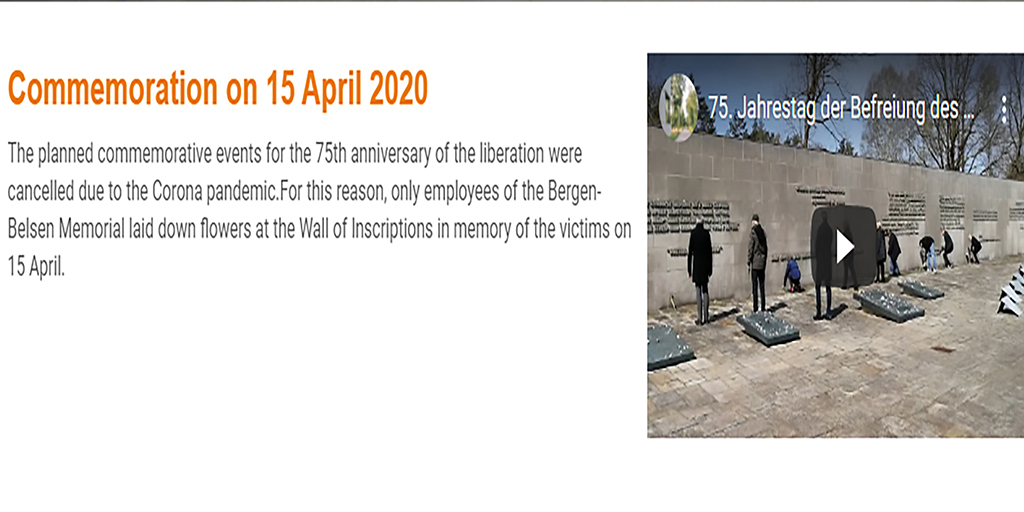
Comparing Online Commemoration Events
As I have discussed in some of the earliest posts on this site, there are distinct differences between in-person commemorative events and online activities designed to mark such occasions, yet the latter in many ways attempt to mirror the former. I have talked about the way materiality is still significant when taking part in physically-distanced commemorations and considered the centrality of site when we cannot gather in a specific place. In this blog, I reflect upon some of my more recent close analysis research into two online commemorations that occurred in 2020:
- The UK Yom HaShoah Ceremony
- The 75th anniversary of the liberation of Bergen-Belsen
Approaching Online Commemorations as ‘Events’
In my research I have been trying to understand if the form of commemoration events changes when they are forced online. Inspired by an Aristotelian approach to form, I distinguish materiality from form and define the form of commemorations as ‘sacred repeated activity’.
By this I mean:
- Sacred – intense communal affect (sacred here then does not refer to Religion specifically although it can include religious ceremonies)
Repeated – must have a primary event that cannot/must not be repeated but which is marked by repeated activities (often annually)
Activity – They involve embodied participation from the defined memory community (i.e. ‘the communal’ who share in the sacredness of the event)
Co-mmemoration after all is about remembering ‘together’, ‘collectively’ as a ‘community’. Whilst this suggests we must be physically in the same place, what interests me is whether intense communal sacred affect and embodied participation is experienced in digital initiatives.
Making this conscious departure from thinking about material differences between offline and online enables us to move beyond (incorrect) assumptions that online activity is immaterial. Rather, it encourages us to focus on the cultural phenomena that move between offline and online spaces.
I consider whether the form of commemoration has altered between in-person and online ‘events’ through these three distinct signifiers of its form with the following questions:
- How do they construct a specific memory community?
- How do they create a sense of togetherness?
- How do they evoke intensity?
- To what extent do online commemoration events foreground embodiment?
- How do participants perform bodily activity during these events, and how is this presented?
- To what extent are these activities repetitions of previous in-person events?
Comparing Commemoration Events
UK Yom HaShoah Ceremony
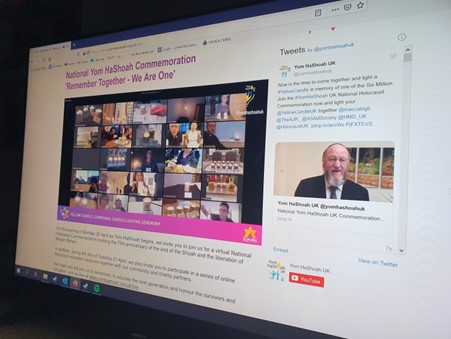
A Screenshot of the live-streamed ceremony, April 2020
The 2020 event can be accessed on the website.
Yom Hazikaron IaShoah ve-laG’vuah (or Yom HaShoah for short) means Holocaust and Heroism Remembrance Day. It is commemorated in Israel as part of a series of national memorial events, but is also marked by the international Jewish diaspora. Whilst Holocaust Memorial Day, 27th January, marks the liberation of Auschwitz-Birkenau and keeps the image of the weak Jewish camp victim in the imaginary, Holocaust and Heroism Remembrance Day focuses on the image of Jewish resisters, remembering the Warsaw Ghetto Uprising particularly. Although, seemingly paradoxically, the UK 2020 online event also marked 75 years since the liberation of Bergen-Belsen: a significant event in British memory of the Holocaust and an anniversary that fell only 5 days before Yom HaShoah this year.
This event establishes its memory community to be British Jews primarily, but spoke to the wider international Jewish diaspora and linked both to Israel. Repeatedly the Master of Ceremony, Henry Grunwald and other speakers referred to Yom HaShoah as:
our day to mark our personal and communal lost (whilst recognising and welcoming the presence of) special friends from outside our community.
The Magen David (or Star of David) features prominently in the holding page’s logo and on the banner at the bottom of the live-stream screen, the image of a remembrance candle is centre in front of it.
The live-streamed ceremony, which I watched on April 20th 2020 (27th Nisan in the Jewish calendar), included a number of elements that were repeated rituals:
- young people making a memory pledge for the future
- the singing of the Hatikvah (‘The Hope’), now the Israeli national anthem
- the singing of the British national anthem (‘God Save the Queen’)
- a performance of the Yiddish Partisan Song ‘Zog nit keyn mol’, originally penned in the Vilna Ghetto in 1943 inspired by the news of the Warsaw Ghetto – a song which is often repeated at Holocaust memorials
- The Holocaust memorial prayer
- the reading of a kaddish. Although, the speaker notes, ‘we don’t usually say a kaddish without a minyan’ (10 Jewish men) but he recognises the significance here to break with a material/physical tradition as the significance of the kaddish for Holocaust memory far outweighs it.
The event’s narrative presents a transgenerational community, including school choirs, the teenager pledgers, Holocaust survivors and their children, as well as Jewish celebrities, who participate in telling the history stories of the Kindertransportees, ‘the Boys’ and Bergen-Belsen: key events that shape British memory of the Holocaust. Notably absent are narratives of British internment camps for German Jews and any mention of Beau Bassin, a detainment camp under British colonial rule in Mauritius. British non-Jews are celebrated as heroes: as rescuers and liberators.
A particularly moving moment in the ceremony is pictured below. A series of six survivors light candles. Each candle, delivered to them as part of the Yellow Candle Project, contains a card with the name and details of a Holocaust victim. In this case, it is the survivors’ own relatives. We watch them in sequence, as their images fill the screen. Then we see all six in a split-screen. We then see all of the official contributors in multiple screens, before Grunswald welcomes participants (at home) to do the same with the candles they have received. They do, and many share their candle lighting on Twitter using the hashtag #YellowCandles, these are retweeted in the live Twitter feed next to the event’s live-stream.
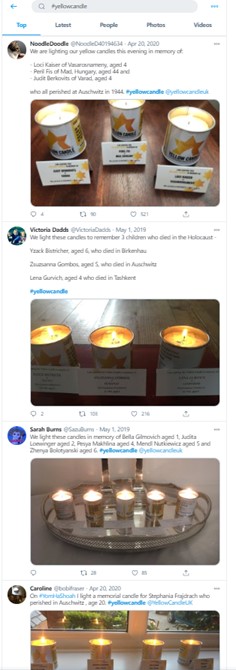
Here, very much like similar in-person events, a communal affective intensity is evoked through the synchronous and embodied participation of attendees lighting their candles and sharing this candle lighting to each other on social media. Knowing others are doing the same action at the same time, regardless of geographical distance reminds us of Benedict Anderson’s writing on the ‘imagined community’, yet this community is also simultaneously represented back at the participants here through the multiple screens on Zoom. We go from a single survivor to six to multiple participants onscreen to the wider community further afield. So we might say it is not simply an imagined community that is provoked here by digital media, but a represented community and those at home can participate in the representation.
The 75th Anniversary of the Liberation of Bergen-Belsen
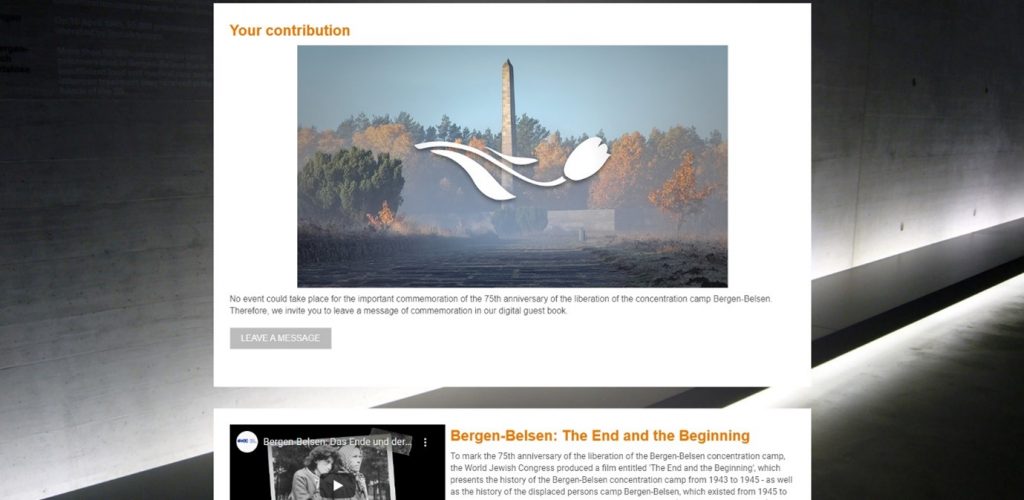
The 75th anniversary of the liberation of Bergen-Belsen is a very different event. Whilst the UK Yom HaShoah event is usually held in a large space such as a stadium, the specificities of the site are unimportant. It just needs to accommodate a crowd. There were numerous concentration camps liberation between 1944-45, the distinction of the Bergen-Belsen event from the others is its geographical site.
Whilst the in-person ceremony planned to host 5,000 guests; the online commemoration still had a site-based element but the ritualistic activity of dignitaries and staff laying wreaths was broadcast out to the international community. Whilst the Yom HaShoah event required younger generations to pledge to remember their cultural ancestors, the liberation event spoke of ‘we’, German people and particularly German dignitaries, who pledge to remember for ‘you’, the people of different cultures, religions and nations that ours hurt.
The commemoration ‘event’ exists in three forms:
- An NDR live television broadcast at the site, which includes pre-recorded clips and the small-scale wreath laying ceremony on 15th April. The broadcast ends with a hashtag #bergenbelsen75
- The website www.befreiung1945.de (note: currently much of the content on the website seems to be down) which is mostly constructed of short video clips which together are suggestive of a typical in-person event: speeches from an academic expert, a survivor and representatives of Jewish, and Roma and Sinti communities. It also includes the full NDR broadcast translated into multiple languages and clips of young people performing solo versions of the traditional Lichten aud Schienen ceremony, or Lights on the Track. In which they usually light candles and repeat the words of survivors, and a video of summer school participants, who offer their reflections on memory culture. This invites people to participate with their own reflections via a hashtag #bbandme (which has not always been used to commemorate this site or the Holocaust), and there is also a digital guestbook on the website, which to date has received messages from people in France, Germany, Poland, the Netherlands, Israel and Australia.
- The commemoration of the liberation of Bergen-Belsen also persists as part of a wider online education campaign led by Iris Groshek, who was formally Head of Education at Neuengamme Concentration Camp memorial, she used hashtags and a curated Twitter account @75Befreiung to bring together authorised or official commemorative activities related to #Liberation75 or #75Befreiung. What was once a network of camps where horrific violence was performed now became a memory network of sites and organisations commemorating victims and survivors.
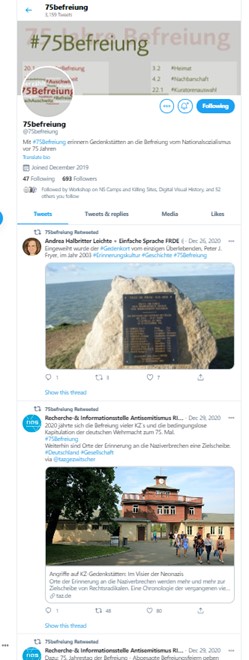
On one hand, the physical repetition of the wreath-laying and the Lights on the Track ceremony at Bergen-Belsen resisted any possibility of both the form and material signifiers of commemoration being altered for the 2020 event, despite the restrictions of the Pandemic. This is perhaps illustrative of quite how important the sense of duty to remember is, in the nation where the Holocaust was planned and managed, and whose people voted for Adolph Hitler to come to power, many of whom then became explicit perpetrators or at least complicit in genocide.
On the other hand, by hosting these small-scale ceremonies, the communal intensity of the moment was diminished as the reporting journalist referred to the audience at home as ‘you’, and used terms like ‘viewers’ and ‘broadcast’ emphasising the distance between those of us who watch and those that were invited to physically participate in that moment at the site.
Yet, the sense of communal intensity is not lost. The use of hashtags, and particularly the integration of the Belsen event into the wider networked project of #75Befreiung dispersed this intensity across not only space but time. The project ran from the end of January through to May and kept Belsen, Sachsenhausen, Neuengamme, Dachau, Ravensbruck, and other memorial sites across Germany visible in the public space and prominent in public consciousness for a longer period than a momentary event held at a particular site on a specific day.
This suggests that the networked logics of the digital may offer new possibilities for commemorative forms, does it change the form, i.e. halt the sacredness and repetitiveness of the activity? I think not. However, it certainly reconceptualises the idea of communal affective intensity. Rather than this having to come in culminative moments at specific geographical sites, or through actions such as the YomHaShoah candle lighting, #75Befreiung illustrates that communal affect can also be spread across time and space in ways that encourage intensity through their longevity.
The question remains, how to encourage this intensity to persist across time and space, and in communal ways. It is noticeable that #75Befreiung privileges the voices of institutions. In contrast, the UK Yom HaShoah event encouraged communal participation and representation but for only a brief moment, much like in-person events.
- How can a longitudinal networked form of intense affect persist in communal rather than institutional ways?
- Can such a networked form of intense affect be produced offline as well as online?
In this post, I have offered a close reading of two commemorative events in 2020, for a wider analysis of remote commemorations during the Covid-19 Pandemic I recommend this piece by Dr Tobias Ebbrecht-Hartmann at the Hebrew University, Jerusalem.